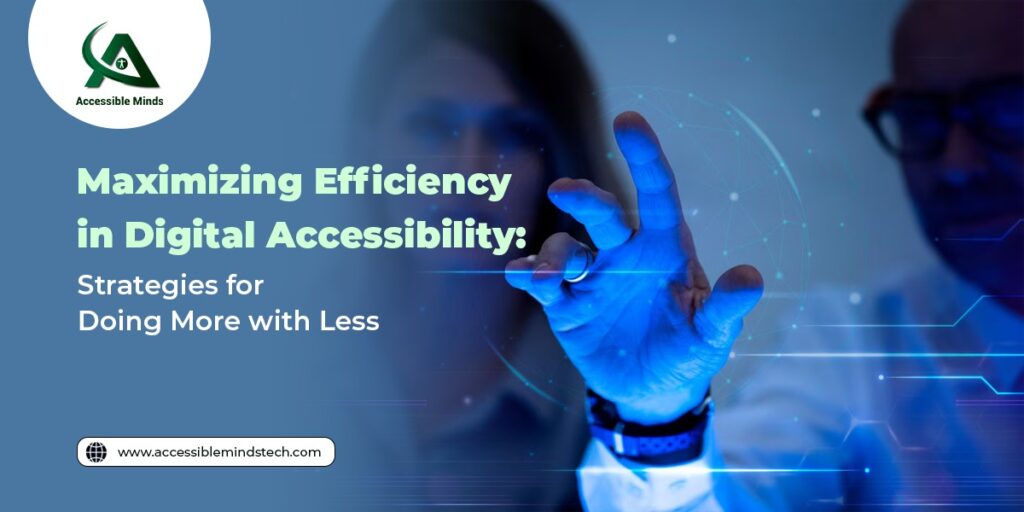Digital accessibility is a crucial aspect of web and software development, ensuring that digital content is usable by all individuals, regardless of their disabilities. As organizations strive to meet accessibility standards and create inclusive user experiences, the challenge lies in achieving these goals efficiently. Digital accessibility services provide the expertise and tools needed to streamline this process. This blog explores strategies for maximizing efficiency in digital accessibility, leveraging data and statistics to highlight the importance and impact of these efforts.
The Importance of Digital Accessibility
Digital accessibility is not just a compliance issue; it’s a matter of social responsibility and inclusivity. According to the World Health Organization (WHO), over 1 billion people, or about 15% of the world’s population, live with some form of disability. Ensuring that digital platforms are accessible to this significant portion of the population is essential for equal access to information, services, and opportunities.
Moreover, the legal landscape is becoming increasingly stringent. In the United States, the Americans with Disabilities Act (ADA) requires digital content to be accessible. Non-compliance can result in costly lawsuits and damage to an organization’s reputation. For example, in 2020, there were over 3,500 ADA website accessibility lawsuits filed in federal court, a 23% increase from 2019.
Strategies for Maximizing Efficiency in Digital Accessibility
- Integrate Accessibility Early in the Development Process
One of the most effective ways to maximize efficiency is to integrate accessibility considerations from the very beginning of the development process. By incorporating accessibility into the design and development phases, organizations can avoid costly and time-consuming retrofits later on. This proactive approach ensures that accessibility is a fundamental aspect of the product, not an afterthought.
- Utilize Automated Testing Tools
Automated testing tools are invaluable in identifying and addressing accessibility issues quickly. These tools can scan websites and digital content for common accessibility problems, providing immediate feedback and solutions. While manual testing by experts is still necessary for comprehensive evaluation, automated tools can handle repetitive tasks efficiently, saving significant time and effort.
Popular automated testing tools include:
- WAVE: Provides visual feedback about the accessibility of web content.
- Axe: Integrates with browsers to evaluate web pages for accessibility issues.
- Pa11y: An open-source accessibility testing tool that runs automated tests on web pages.
- Leverage Digital Accessibility Services
Partnering with professional Digital Accessibility Services can greatly enhance efficiency. These services offer expertise and resources that might be lacking in-house. They provide comprehensive audits, remediation guidance, and ongoing support to ensure that digital content meets accessibility standards. By outsourcing this specialized work, organizations can focus on their core activities while ensuring high accessibility standards.
- Adopt a Component-Based Design Approach
A component-based design approach involves creating reusable, accessible components that can be consistently applied across various digital products. This method ensures that accessibility is built into each component, reducing the need for repeated accessibility checks. Once a component is verified as accessible, it can be reused confidently, streamlining the development process and ensuring consistency.
- Conduct Regular Training and Education
Empowering your team with knowledge and skills in digital accessibility is crucial. Regular training sessions can keep everyone up to date with the latest accessibility standards and practices. By fostering a culture of accessibility awareness, organizations can ensure that all team members understand the importance of accessibility and how to implement it effectively in their work.
Training can cover:
- WCAG Guidelines: Detailed understanding of the Web Content Accessibility Guidelines (WCAG).
- Best Practices: Practical techniques for designing accessible content.
- Tool Usage: How to effectively use automated testing tools and other resources.
- Implement User Feedback Mechanisms
Incorporating feedback from users, especially those with disabilities, is essential for creating truly accessible content. Establish mechanisms for collecting and analyzing user feedback on accessibility. This direct input can provide valuable insights into real-world usability and identify areas for improvement that automated tools might miss. Engaging with the disability community can also foster a more inclusive approach to design and development.
- Prioritize and Triage Accessibility Issues
Not all accessibility issues have the same impact. Prioritizing issues based on their severity and the number of users affected can help organizations address the most critical problems first. By focusing on high-impact issues, organizations can make significant improvements in accessibility with limited resources. Triage strategies ensure that efforts are directed where they will have the most substantial effect.
Benefits of Efficient Digital Accessibility
Maximizing efficiency in digital accessibility brings numerous benefits:
- Cost Savings: Reducing redundant work and avoiding costly retrofits saves money.
- Faster Time-to-Market: Efficient processes ensure that products are accessible and ready for launch more quickly.
- Improved User Experience: Consistently accessible content enhances the overall user experience for all users.
- Regulatory Compliance: Staying compliant with accessibility regulations avoids legal risks and potential fines.
Conclusion
Maximizing efficiency in digital accessibility is essential for organizations seeking to create inclusive digital environments while managing resources effectively. By prioritizing accessibility from the start, utilizing automated testing tools, implementing scalable strategies, leveraging existing resources, providing team training, engaging users with disabilities, adopting iterative improvement processes, and utilizing cost-effective digital accessibility services, organizations can achieve more with less. These strategies not only ensure compliance with accessibility standards but also enhance the user experience for all, demonstrating a commitment to inclusivity and social responsibility. As digital accessibility continues to evolve, staying proactive and efficient in your efforts will position your organization as a leader in creating accessible digital content.

